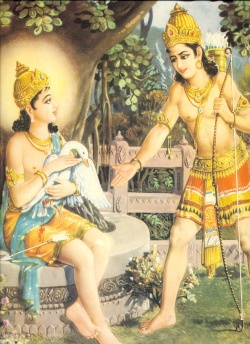Fire
- See also :
- See also :
Fire appears as the flames of undesirable forces in the mind.
Thus the Three Fires of
Lust and
Illusion which must be allowed to die for lack of fuelling.
See the ‘Fire Sermon of the Buddha’
. For the psychophysical heat induced by special meditation in Tibet, see Tum-mo.
Fire: is about heat, warmth, light, passion, and knowing. Too strong and it burns, consuming everything it touches.
Too weak, and nothing happens, and all is desolate. In reaction, it turns everything to ash. In response, it warms, motivates, provides the energy for things to happen.
Most of the rituals of Brahmanism, the main religion at the time of the Buddha, centered around fire (aggi).
Agni, the god of fire, also sometimes called Jātadeva (Ja.I,286; IV,51), is invoked in the Ṛg Veda more than any of the other deity.
The Vedic sacrifice consisted of three fires,
the āhavanīya,
the gārhapatya and
the dakṣīṇagni
.
There were also the three fires of the household, the primary one being the birth fire (jātaggi, Ja.II,43) which was ignited when a person was born and from which their funeral pyre was ignited when they died.
It was essential that these fires be kept burning throughout a person's life.
Walking seven times (saptipadi) around the nuptial fire, also lit from the birth fire, sealed the marriage.
Apart from these sacred fires, brahmans who renounced the world to become ascetics worshiped Agni by tended a sacred fire in the jungle.
This fire was likewise ignited by the birth fire (Ja.I,494).
It seems that the Buddha chose to itemize the three main mental defilements (greed, lobha; hatred, dosa; and ignorance, moha) and call them fires, to parallel and contrast with the sacred fires of Brahmanism (Vin.I,35).
Brahmanism required that the three fires be tended and kept burning, the Buddha taught that one attained enlightenment only by abandoning the three fires and extinguishing them.
Of the several names he gave to the state of complete liberation the most common was Nirvāṇa, meaning `to blow out', i.e. to blow out the burning mental defilements.
He commented that a monk will not make offerings to the sacred fire (aggihoma, D.I,9) and in the Dhammapada he said; `
If one were to attend the sacred fire for a hundred years in the forest or were to honour even for a moment one who had developed himself, that honour would be better than the hundred years of sacrifice.'(Dhp.107).
The early Buddhists considered fire worship to be as foolish and ineffective and several stories in the Jātaka pokes fun at it (e.g. Ja.II,43-40; VI,206-7).
In one of these, an ascetic decided to offer an ox he had been given to Agni.
Not having salt for the meat he went off to get it, tethering the animal near the sacred fire before going.
While he was away a band of robbers came to his hermitage, slaughtered the ox, cooked the meat, eat their fill, and left nothing but the hide, tail and bones.
When the ascetic returned and saw what had happened he said; `
If Jātadeva the cannot protect what is his how can he protect me?'
He dumped what the remains of the ox into the sacred fire and then threw a bucket of water over it (Ja.I,494).
After the 7th century CE the fire ritual was one of many Brahmanical rites incorporated into Vajrayāna Buddhism.
In Tibetan Buddhism it is called sbyin-sreg and in Japanese Shingon Buddhism goma.
See Vedas.
